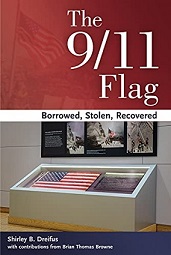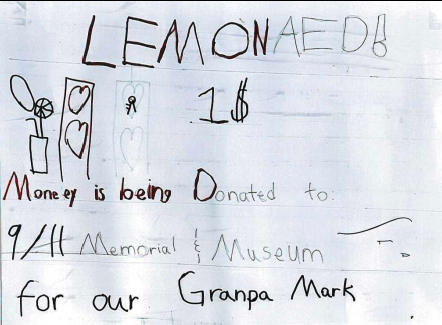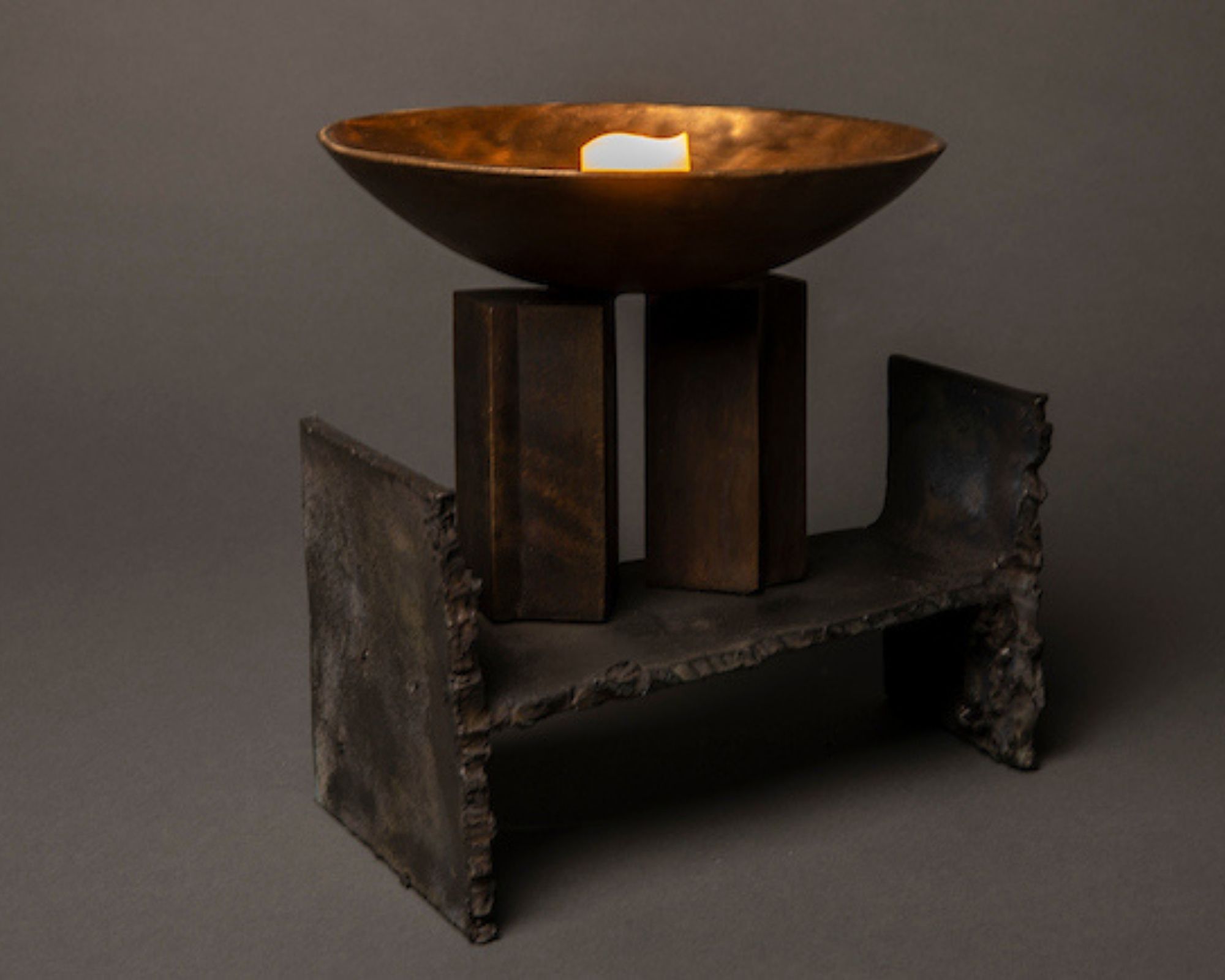Make a donation to the museum
The Gift of Lights: Tobi Kahn’s “YZKAR”
The Gift of Lights: Tobi Kahn’s “YZKAR”
- November 22, 2021
A Special Post by Our Chief Curator
Throughout 2021, the 9/11 Memorial Museum received a number of collection donations mindful of the milestone anniversary we marked this year. Among the outstanding recent gifts is Tobi Kahn’s sculpture “YZKAR,” a pair of bronze-cast lights which invite reflection about and engagement with the acts of individual and communal memorialization.
In this video, we hear three perspectives on the piece, from the sculptor himself; Alice M. Greenwald, our President and CEO, speaking for the Museum; and benefactor William A. Brewer III, attorney, on behalf of the Brewer Foundation, which commissioned the work.
Tobi Kahn
The child of Holocaust survivors, New York City-rooted Kahn is personally sensitive to memory preservation, especially as the trauma is handed down from eyewitnesses to a new generation that will serve as caretakers of history. The 9/11 Memorial Museum serves as a catalyst for memory retention by leveraging the authenticity of its site and evidentiary holdings. The Brewer Foundation, which fosters the leadership capacities of young people, recognizes that tolerance, empathy, and historical mindfulness are essential for this cohort of emerging leaders.
Two decades beyond that fateful Tuesday, intergenerational transfer of knowledge about 9/11 takes on more urgency as increasing numbers of visitors to the Memorial Museum arrive without a lived connection to the date or any links to 9/11 victims or survivors. What will this definitive 21st-century tragedy mean to our descendants who did not experience it, or whose own defining crisis will be fused with the Covid-19 pandemic?
Left: "Individual 9/11 Memorial Light." Right: "Communal 9/11 Memorial Light." Photos: Jin S. Lee
Kahn’s inseparable lights were not created to convey historical facts, but rather to encourage actions essential to remembrance. Standing upright like a person, the “Individual 9/11 Memorial Light” pillar invites us to consider the distinct, irreplaceable lives caught in the vortex of this crime against everyday humanity - men, women, and children, like ourselves. The complementary “Communal 9/11 Memorial Light” shifts focus to the collective loss and bereavement experienced by society in the wake of the terror attacks. The metal arms on which its twinned support pillars rise extend outward. The gesture is evocative of an intimate embrace, in the way elders pull younger relatives and community members close to share important stories or impart difficult lessons. “YZKAR,” a word invented by Kahn, also summons to mind the Hebrew term “Yizkor" - traditional prayers for the dead recited publicly in synagogues on holidays such as Yom Kippur and Passover.
On the morning of September 11th, Kahn observed the mauling of lower Manhattan’s skyline from the roof of his Long Island City studio. Finding that he could neither un-see nor un-feel this catastrophe, he sought for years to craft a response emerging from his long practice of confronting the vulnerabilities of the human condition as well as his faith in art as a redemptive, healing force. Throughout his career, Kahn’s concerns have embraced the secular as well as the sacred. In turn, he has conveyed those ideas through a multiplicity of media, shifting fluidly from paint and graphic arts to metal, ceramics, wood, and combinations thereof.
Produced from these intense, early ruminations about 9/11 was a sculptural piece Kahn titled “M’AHL,” completed for and exhibited during the 10th anniversary of the attacks. It assumed form as a floor installation of 12 interrelated segments assembled from leftover workshop wood scraps. These were then overpainted to evoke the spectral ash coating lower Manhattan in the immediate aftermath of the World Trade Center’s destruction. More abstraction than representational, “M’AHL” harnessed memories of trips that Kahn had taken with his family to the Twin Towers, the first, with his grandfather, the last with his own son only weeks before September 11. It also channeled his impressions of overlooking the cityscape from those bird's eye elevations. In 2016, the installation was reassembled for the Museum's special exhibition Rendering the Unthinkable: Artists Respond to 9/11. One luminous component of the original artwork now resides in our permanent collection.
Last year, Kahn had the opportunity to re-process a response to 9/11.
In a gallery talk at the Museum several years ago, he noted, “Life is a continuum. What we remember is continually being transformed by imagination.”
The two-piece “sacred” sculpture “YZKAR,” born from the Brewer Foundation commission, attests to that imaginative, evolutionary openness.
As tools for mourning rituals, luminaires and candle-holding devices are virtually universal to world religions, and light shrines are well-represented in Kahn’s multi-faith oeuvre. Each piece from “YZKAR” incorporates an illumination receptacle. Distinctive to this work is not its function but its source of inspiration. For the undertaking, the artist received two fractional pieces of original World Trade Center architectural steel entrusted to him through senior-level contacts at the Metropolitan Transit Agency and the Port Authority of New York & New Jersey.
This transfer merits brief explanation. Once clean-up operations at Ground Zero concluded, the Port Authority decided to set aside some remaining witness metal for commemorative and educational use by organizations and communities that met their pro-bono release criteria. Qualifying proposals proved so numerous that by 2017, when the steel adoption program ended, these reserves were almost wholly distributed. Prudently, a few smaller relics were laid aside for selective future donations. Kahn's idea to fashion a "sacred artwork" derived from this remnant metal resonated; resulting in two pieces granted to him for project use.
For weeks thereafter, Kahn lived with these artifacts, studying them as he pondered his aesthetic strategy. Ultimately, he determined to leave them untouched. Instead, he decided to appropriate their powerful authenticity and generate facsimiles that would be cast in bronze. Each relic’s physical characteristics and authentic patina would inform its resulting “light” assemblage. Three bronze sets of paired lights were produced under his direction at Stewart Sculpture Casting in Lambertville, NJ. One version was presented to New York University. Another awaits placement at a non-denominational neighborhood gathering and reflection space in lower Manhattan. Through the Brewer Foundation’s generosity, the Memorial Museum was gifted the final edition of “YZKAR” in remembrance of the 20th anniversary of the attacks.
At a juncture when public recognition of 9/11 is shifting from actively shared memory to past event, “YZKAR” retains a notable material significance. Kahn’s homage to the victims and witnesses of 9/11 also memorializes the steel from the towers set aside for these kinds of tangible tributes. Remarkably, 20 years after the catastrophe that dismantled the World Trade Center, that former mountain of 1.8 million tons of metal debris has been given away, salvaged, repurposed, and essentially exhausted. The legacy of that foundational metal endures, however, embodied in the forms of Kahn’s memorial lights.
By Jan Seidler Ramirez, Chief Curator and EVP of Collections.
Note: YZKAR will be on view at the Museum in early 2022.
Previous Post
New Book by Shirley Dreifus Chronicles Mystery of 9/11 Flag

In her newest book, author Shirley Dreifus chronicles the fascinating story of the stolen "9/11 Flag." She'll join us for a book signing tomorrow from 12-3 p.m. at the Museum.
Next Post
Lemonade Stand Becomes Sweet Fundraising Effort

Mark Hemschoot died on 9/11 while at work at the Aon Corporation in the South Tower. Today, the entrepreneurial spirt of his four grandchildren - ages 8, 6, 3, and 11 months - keeps his memory alive.

